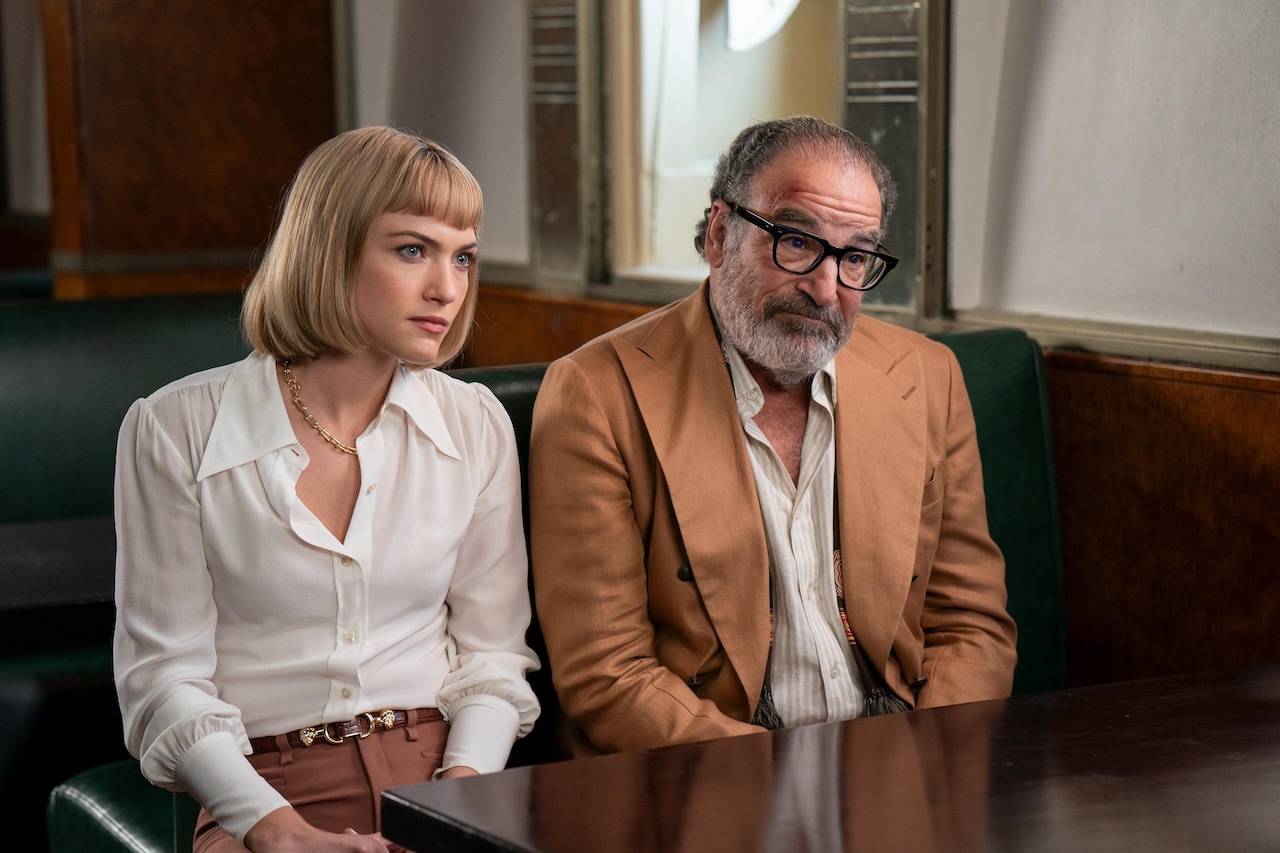“We think that the world finds itself in a moment of chaos and confusion on so many different fronts that rewrote the rules of civil society overnight for almost everyone on Earth,” says co-creators and co-showrunner Mike Weiss about his whodunnit TV show Death And Other Details.
This sets the stage (and screen) “for a diverting bit of entertainment that is also smart and clever and demands that an audience pay attention so that they don’t miss anything that’s going to be important for them to figure out what’s going on at the center of the murder mystery that they’re engaged with.”
“And I think that where ours fits inside of those stories is we wanted to create something that both paid homage to the genre, but also with a brand new character,” continues Heidi Cole McAdams who shares duties with Mike Weiss.
Death And Other Details stars Detective Rufus Cotesworth (Mandy Patinkin) and his protégé, Imogene (Violett Beane) and employ expected tropes of the genre beginning with a murder that must be solved. This it the fork in the genre road where many character similarities end. The show avoids the typical stoic detective with and eagle eye and impeccable powers of deduction followed by a much younger assistant who’s all too eager to learn.
Imogene finds herself on the crime-solving team after she’s a suspect in a murder on a Mediterranean ocean liner. “Imogene is lost and she finds herself and her purpose in solving this mystery in addition to proving her innocence,” continues Heidi.
“Rufus Cotesworth, is a really unique version of the world’s greatest detective. It’s a trope and a type of character that we and audiences clearly love. Great actors have played great versions of that character in the past, but we wrote a really flawed character. We leaned into all of the ways in which he’s brilliant, but flawed as a detective. He’s not Sherlock Holmes. He makes mistakes and covers them up brilliantly but would admit to them privately later,” mentions Weiss.
“He does work with an assistant at the beginning, but by the end of the season, he becomes an assistant in a way to Imogene Scott, who is brilliant and lost, as Heidi, but is also incredibly capable and clever,” Mike notes.
Curiously, Cole McAdams and Weiss weren’t a writing duo until they collaborated on the pilot for the show. “We found the specific tone and the way our characters speak on the page,” she adds. Heidi describes the tone of Death And Other Details as “contemporary with a tiny tinge of something that makes it feel more heightened.”
Timeline to Greenlight
Director Mark Webb (Gifted, The Amazing Spiderman 2) had a kernel of an idea to make a murder mystery on a boat. Mike Weiss and Heidi Cole McAdams went away and built out the bones of the show. “We built the, who is Imogen, why is she on the boat, what’s her relationship with Rufus?” says Heidi.
After some minor adjustments, they pitched it to ABC Signature in the fall of 2020. Following some feedback they pitched it Hulu executives in early 2021 and they bought the idea in the room and they were off to the races. Weiss and Cole McAdam wrote an outline for each episode followed by a script.
They also wrote a format document which is a look book pitching document of sorts. “It’s a 25 page document covered with lots of pictures and a little bit of text that tells you this is what the show is going to be if you let us make this show,” states Heidi. They submitted the format in May 2021 and were greenlit in July. The pilot was shot in the fall of 2021.

Heid Cole McAdams. Photo by Yasara Gunawardena
After viewing the pilot as a proof of concept, Mike and Heidi wanted to implement some changes should they make the rest of the season. Hulu executives approved their plan. “We hired a group of writers. We wrote the season, including the changes to the pilot over the first six months of 2022. We filmed from August to December 2022.”
Mike Weiss doesn’t consider the changes that were made to the show as being a course correction. “There are different versions of the show that reveal themselves and you try things. There was a more comedic version of the show at one point. There was also a stranger, more conspiracy laden version of the show.” This is all part of the development journey.
Meet Rufus Cotesworth and Imogene Scott
The crime-solving duo are both damaged individuals who heal together. “Rufus is connected to the tragedy of Imogene’s life. When she was a little girl, she lost her mom. And then, during that investigation, she found in Rufus a father figure who was committed to solving that crime, but also who saw something in her that other people didn’t necessarily notice, which is that she’s brilliant and that she sees the world in a way that other people don’t,” explains Heidi.
Rufus offers Imogene some guidance and structure to allow her to move from “a purposeless life of being a paid friend and become what she’s meant to be.” All the while, Rufus is navigating his imposter syndrome because he knows he’s not the world’s best detective as he claims. “But he receives immense joy from letting her see how brilliant and capable she is, and to not hide her skills and her talents,” says Mike.
Building Out The Plot
Murder mysteries are notoriously plot-heavy as they guide and misguide their audience through a maze of clues which eventually unveil the murderer. This is why an invested writers’ room is so important.
“I think that the collaborative nature of writing television helps in pacing out plot and making it have the right level of twists without getting confusing,” states Heidi. “If somebody in the writers room is confused, then we’ve gone too far.”
Mike Weiss quotes showrunner Bruno Heller’s (The Mentalist) guiding principle to writing. “A good episode of television should have a story that is simple enough that you could explain it to a kindergarten. It also needs to be sophisticated, witty, stylish, surprising, interesting added onto it. But the idea is that each week-to week each episode should be a simple journey that the audience can track.”
Building Tension
“The amount of tension in the show feels like something that we arrived at intuitively. You can only build up tension for so long before it becomes preposterous and you’ve got to release it,” declares Mike Weiss.
“We talked about having the show become more tense and having the game become more deadly as the season progressed. That was the global thing that we had our eye on, maybe even more than tension in individual episodes.”
“The idea of building tension and convincing the audience that characters who they might have fallen in love with, who they think are safe, could get killed. That was something that we tried really hard to manage and convince the audience that there were real stakes.”

Mike Weiss. Photo by Yasara Gunawardena
Heidi Cole McAdams has a more esoteric take on tension. “I think that a lot of the tension comes from the character’s secrets rather than physical danger. We really wanted to make a show that felt like an escape and fun. Even though there is a certain amount of danger as the season goes on, we never wanted it to be too scary or too tense.”
Flashbacks – Memory Moments
Death And Other Details revels in its use of flashbacks. Typically, they are used as expository devices to gradually reveal relevant clues about the murder.
“We talked about them as memory moments rather than flashbacks for time travel because we really liked the idea of exploring memory and how it works inside a murder mystery,” elaborates Heidi Cole McAdams.
Mike Weiss recalls consulting with actual detectives on Chicago PD on the matter of unreliable narrators. “One of the basic obstacles that a real detective has is that eyewitnesses will misremember and distort the truth unintentionally. Not out of malice or ill will, but in their attempt to remember, they will forget, they will invent, they will augment the oral history of events, which we found super interesting and helpful to a murder mystery plot.”
This process is especially useful when Imogene is transported to her past. “It’s not a perfect past. It’s a past influenced by the present day,” adds Heidi.
Writing Advice To Murder Mystery Writers
“I think if you can describe your story verbally to a friend or even a stranger, and they can follow it and find it entertaining and surprising, that you probably have enough there to build an entire story around,” says Weiss. ”
“It’s very easy inside the genre to create something that’s too complicated and too complex and that isn’t being driven by a key emotional question that’s burning to be answered. Instead, the journey gets lost in unnecessary complication and twists.”
Heidi’s advice is also noteworthy. “I think one of the things that we feel very strongly about in this genre is that you play fair with the audience.”
“A lot of murder mysteries take a misstep when you don’t do that, when you don’t meet all the suspense from the beginning, when you’re making sure that if you go back and watch it from the beginning, and you know what really happened, all the clues line up.”
This was the core of many changes they made to their original pilot. It posed a challenge to the ongoing writing process because if the clues aren’t properly stacked, the show will unravel later. Clues and plot twists should be organic and unforced.
Planting solid clues and paying them off later allows each episode to function as a stand alone. “Each episode has its own identity,” says Weiss.
Aside from having robust, fair clues. Weiss is cognizant of story logic to make the series make sense. “But, at some point, there is a certain amount of heightened stretches of believability to be entertaining.”
